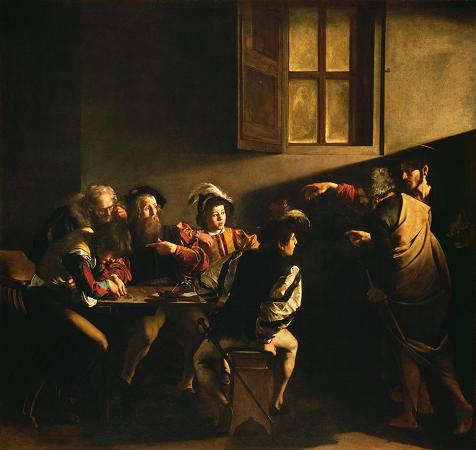Seven Acts of Mercy (c1607). Oil on canvas. 390 x 260. The Seven Works of Mercy, also known as The Seven Acts of Mercy, is an oil painting by Italian painter Caravaggio, circa 1607. The painting depicts the seven corporal works of mercy in traditional Catholic belief, which are a set of compassionate acts concerning the material needs of others. The painting was made for, and is still housed in, the church of Pio Monte della Misericordia in Naples. Originally, it was meant to be seven separate panels around the church; however, Caravaggio combined all seven works of mercy in one composition which became the church's altarpiece. The painting is better seen from il coreto in the first floor. The titular seven works/acts of mercy are represented in the painting as follows: Bury the dead In the background, two men carry a dead man. Visit the imprisoned, and feed the hungry On the right, a woman visits an imprisoned man and gives him milk from her breast. This image alludes to the classical story of Roman Charity. Shelter the homeless A pilgrim asks an innkeeper for shelter. Clothe the naked St. Martin of Tours, fourth from the left, has torn his robe in half and given it to the naked beggar in the foreground, recalling the saint's popular legend. Visit the sick St. Martin greets and comforts the beggar who is a cripple. Refresh the thirsty Samson drinks water from the jawbone of an ass. American art historian John Spike notes that the angel at the center of Caravaggio's altarpiece transmits the grace that inspires humanity to be merciful. Spike also notes that the choice of Samson as an emblem of Giving Drink to the Thirsty is so peculiar as to demand some explanation. The fearsome scourge of the Philistines was a deeply flawed man who accomplished his heroic tasks through the grace of God. When Samson was in danger of dying of thirst, God gave him water to drink from the jawbone of an ass. It is difficult to square this miracle with an allegory of the Seven Acts of Mercy since it was not in fact the work of human charity. Regarding the sharp contrasts of the painting's chiaroscuro, the German art historian Ralf van Bohren explains the bright light as a metaphor for mercy, which helps the audience to explore mercy in their own lives. Current scholarship has also established the connection between the iconography of The Seven Works of Mercy and the cultural, scientific and philosophical circles of the painting's commissioners. The Seven Works of Mercy was adapted for the theatre in 2016 by the Royal Shakespeare Company. Written by Anders Lustgarten, The Seven Acts of Mercy was directed by Erica Whyman, the Deputy Artistic Director at the Royal Shakespeare Company. Terence Ward created a biographical thriller of the painting of the Seven Works of Mercy, along with how the painting continues to affect lives today with his book, The Guardian of Mercy: How an Extraordinary Painting by Caravaggio Changed an Ordinary Life Today, Arcade, 2016.
more...




